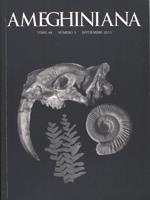PALAEOFLORISTIC ANALYSIS OF THE RIO GUILLERMO FORMATION (LATE EOCENE-EARLY OLIGOCENE?), SANTA CRUZ, ARGENTINA. Macrofloristic Paleogene units of southernmost Patagonia have few palaeobotanical studies. In this paper a new fossil leaf collection recovered from the Río Guillermo Formation (late Eocene—early Oligocene?) is analyzed. The palaeobotanical analysis reveals the presence of 10 fossil species, most of them related to Nothofagus Blume (Nothofagaceae), being the specimens of “Myrcia” bagualensis (Myrtaceae) the most abundant in the collection. Specimens referred to the families Rosaceae, Anacardiaceae, Lauraceae and Fagaceae were also recognized. The palaeofloristic assemblage from the Río Guillermo Formation is dominated by cold temperate taxa suggesting the presence of subantarctic paleofloras in this area. The great similarities between the Río Guillermo flora and that of the Oligocene Loreto Formation, coupled with the palaeoclimatic inferences, might indicate a younger age than previously suggested for the Río Guillermo Formation.
How to translate text using browser tools
1 September 2011
Análisis Paleoflorístico de la Formación Río Guillermo (Eoceno Tardío-Oligoceno Temprano?), Santa Cruz, Argentina
Carolina Panti
ACCESS THE FULL ARTICLE

Ameghiniana
Vol. 48 • No. 3
September 2011
Vol. 48 • No. 3
September 2011
América del Sur
Argentina
Fossil leaves
Hojas fósiles
Palaeogene
Paleógeno
Patagonia




